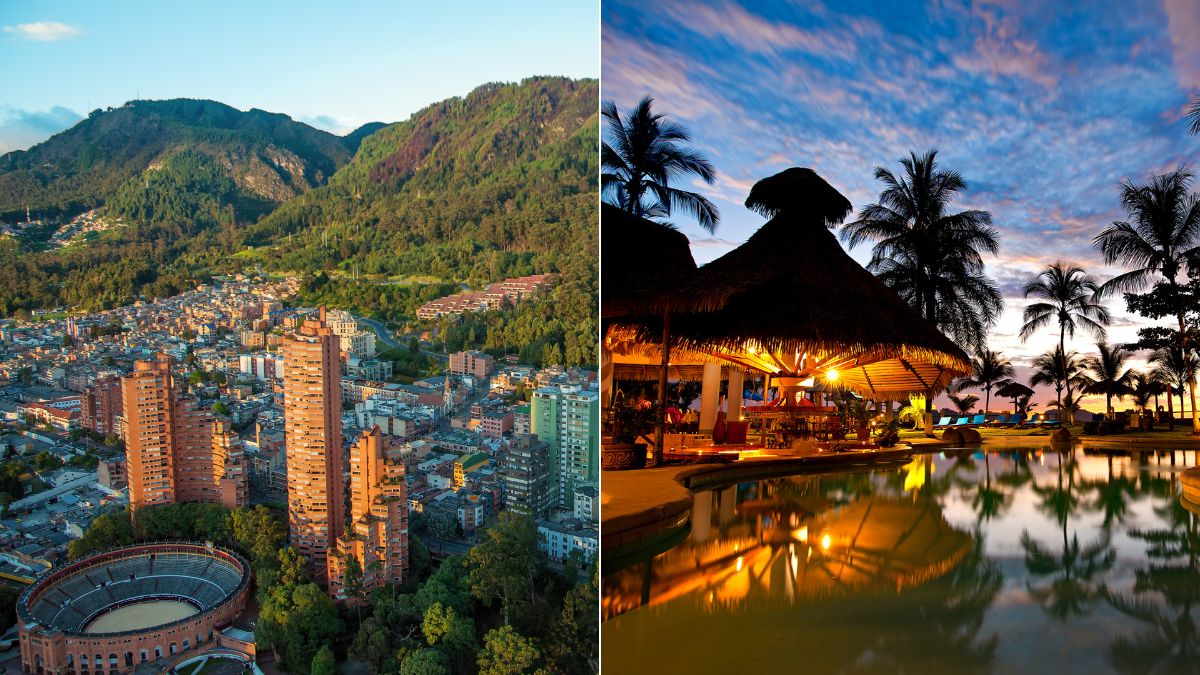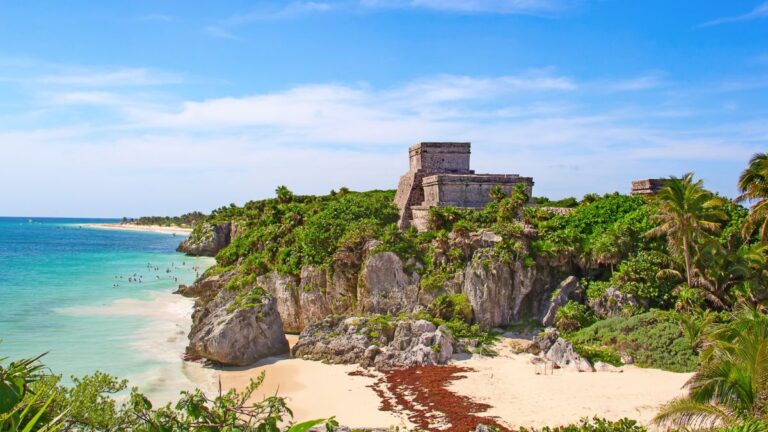Colombia vs. Costa Rica: A Latin American Vacation Showdown

As participants in Amazon Associates and other programs, we earn from qualifying purchases. This comes at no additional cost to you. For more details, see our Affiliate Disclosure.
When choosing between Colombia and Costa Rica for a vacation in Latin America, travelers face a delightful dilemma. Both countries offer rich cultural experiences, stunning natural landscapes, and unique adventures. This showdown compares these two beautiful destinations to help you decide which one might be the best fit for your next getaway.
Natural Beauty and Landscapes
Latin America is renowned for its breathtaking landscapes, and both Colombia and Costa Rica are prime examples of this natural splendor. Colombia, with its diverse terrains, ranges from Amazonian rainforests to Andean peaks, while Costa Rica is famed for its pristine beaches and abundant wildlife. Each offers a distinct experience for nature lovers and adventure seekers.
Colombia
Colombia’s landscape is incredibly diverse, making it a paradise for nature enthusiasts. The Amazon rainforest covers a significant part of the country, offering a unique opportunity to explore one of the most biodiverse areas on the planet. Additionally, the Andean region presents a stark contrast with its towering mountains and verdant valleys. Colombia’s natural beauty extends to its coasts on both the Pacific and the Caribbean, where visitors can enjoy picturesque beaches and crystal-clear waters.
In addition to its natural landscapes, Colombia’s national parks are a major draw. Parks like Tayrona National Natural Park combine tropical beaches with lush forests, providing habitats for a plethora of wildlife species. For those interested in mountainous terrains, the Cocora Valley offers breathtaking views of towering wax palm trees, set against rolling green hills and misty cloud forests.
Costa Rica
Costa Rica is a jewel in the realm of ecotourism, known for its commitment to environmental preservation and sustainability. The country boasts an array of natural habitats, from rainforests to mangroves, attracting nature lovers and wildlife enthusiasts. Costa Rica’s national parks, like the famous Manuel Antonio National Park, are teeming with biodiversity, offering chances to spot rare animals like sloths, monkeys, and various bird species.
The country’s volcanic landscapes add another layer to its natural allure. Arenal Volcano, one of the most active volcanoes in the world, provides a spectacular backdrop for adventure activities and hot springs. Additionally, Costa Rica’s extensive coastline, with both the Pacific and Caribbean shores, offers some of the most beautiful beaches in the region, ideal for surfing, snorkeling, and simply relaxing in a tropical paradise.
While both Colombia and Costa Rica offer stunning natural beauty, the choice largely depends on personal preferences. For those seeking a diverse range of landscapes, from rainforests to beaches and mountains, Colombia might edge out as the more varied destination. However, if your preference leans towards ecotourism and a concentration of wildlife in a more compact area, then Costa Rica’s commitment to conservation and its rich biodiversity make it the superior choice in this category.
Cultural Experiences and Local Life
A trip to Latin America is incomplete without immersing oneself in the rich cultural tapestry and local life of the region. Colombia and Costa Rica, each with their unique heritage and lifestyle, offer distinct and vibrant cultural experiences. From the lively streets of Colombian cities to the tranquil, community-focused life in Costa Rican towns, both countries present a kaleidoscope of traditions, arts, and social customs for travelers to explore.
Colombia
Colombia is a melting pot of cultures, reflecting influences from indigenous communities, Spanish colonial history, and African heritage. This blend is evident in its music, dance, and festivals. Cities like Cartagena and Medellín are not only architectural gems but also hubs of cultural activity. In Cartagena, the colorful streets and historical landmarks speak volumes of its colonial past, while Medellín, once infamous, now stands as a symbol of urban transformation and resilience, with vibrant street art and innovative public spaces.
The cultural experience in Colombia also extends to its rural areas, where traditions are deeply rooted. The coffee region, for example, offers an insight into the life of coffee farmers and the intricate process of coffee production, a vital part of Colombian culture. Moreover, indigenous communities in regions like La Guajira maintain their traditional ways of life, offering a unique glimpse into Colombia’s diverse cultural landscape.
Costa Rica
Costa Rica’s culture is deeply intertwined with its commitment to peace and nature. This philosophy is evident in the everyday life of its people, known as “Ticos.” Ticos are known for their friendly and laid-back attitude, embodying the phrase “Pura Vida” (pure life), which is a mantra reflecting their approach to life. The cultural experience in Costa Rica often involves community and family-centric activities, with a strong emphasis on enjoying life’s simple pleasures.
Despite being smaller in size, Costa Rica has a rich cultural diversity. Its indigenous heritage is preserved in areas like the Talamanca Mountains, while Afro-Caribbean influences are prominent in the Limón province, contributing to the country’s cultural mosaic. Costa Rican traditions can also be explored through its food, which, though not as varied as other Latin American cuisines, is a vital part of its cultural identity, focusing on fresh, local ingredients.
When it comes to cultural experiences and local life, Colombia stands out with its rich diversity, historical depth, and vibrant urban and rural cultures. Its blend of indigenous, African, and Spanish influences creates a more varied cultural landscape compared to Costa Rica. However, for travelers seeking a more laid-back, nature-integrated lifestyle and community-centric culture, Costa Rica’s “Pura Vida” ethos and its focus on peace and nature make it an equally compelling choice. Therefore, Colombia might be preferred for a culturally diverse and historically rich experience, while Costa Rica appeals to those seeking a tranquil, nature-integrated cultural experience.
Adventure and Activities
For travelers seeking an adrenaline rush or engaging activities, both Colombia and Costa Rica offer a treasure trove of experiences. Whether it’s hiking through lush rainforests, exploring ancient ruins, or enjoying water sports, each country provides its own brand of adventure, catering to a wide range of interests and skill levels. The choice between the thrilling escapades of Colombia and the eco-adventures of Costa Rica can make for an exciting decision.
Colombia
Adventure in Colombia is as diverse as its landscapes. For trekking enthusiasts, the country offers challenging hikes like the trek to the Lost City (Ciudad Perdida), a journey through dense jungle that leads to ancient ruins predating Machu Picchu. The Andes Mountains provide opportunities for mountain biking, paragliding, and rock climbing, offering breathtaking views and exhilarating experiences. Colombia’s extensive coastlines also allow for a variety of water sports, including surfing on the Pacific coast and scuba diving in the Caribbean.
Colombia’s Amazon region adds another layer to the adventure, where visitors can embark on river expeditions, jungle treks, and wildlife spotting tours. The unique landscapes of the Tatacoa Desert and the surreal beauty of Caño Cristales, known as the “river of five colors,” provide more unconventional adventures. These experiences not only offer excitement but also a deeper understanding of Colombia’s ecological diversity.
Costa Rica
Costa Rica is synonymous with eco-adventure. The country’s extensive network of national parks and reserves is a playground for nature lovers and adventure seekers. Ziplining through the Monteverde Cloud Forest, white-water rafting on the Pacuare River, and hiking in the shadow of the Arenal Volcano are just a few of the exhilarating activities available. Costa Rica’s commitment to conservation ensures that these adventures are sustainable and in harmony with nature.
Water sports are equally prominent in Costa Rica, with world-class surfing spots on both the Pacific and Caribbean coasts. The country’s biodiversity also makes it a prime location for wildlife tours, bird watching, and snorkeling in areas like the Cocos Island National Park. For those looking for a more relaxed pace, there are countless opportunities for guided nature walks, where the focus is on enjoying the country’s abundant flora and fauna.
If your idea of a perfect vacation includes a wide range of activities across diverse terrains, Colombia might be the better choice. Its varied landscapes provide a backdrop for an array of adventures, from trekking to ancient ruins to exploring diverse ecosystems. On the other hand, if you’re inclined towards eco-friendly adventures and want to engage in activities that are in harmony with nature, Costa Rica’s focus on sustainable tourism and its wealth of national parks offer a more specialized and environmentally conscious experience. Both countries excel in their offerings, but the choice ultimately depends on the type of adventure and the setting you prefer.
Cuisine and Dining Options
The culinary landscapes of Colombia and Costa Rica offer an enticing exploration of flavors and dining experiences. Both countries boast a variety of dishes influenced by their geographical diversity and cultural history. Whether you’re a food enthusiast eager to indulge in exotic flavors or someone who enjoys simple, wholesome meals, these Latin American countries have something to satisfy every palate.
Colombia
Colombian cuisine is a rich blend of indigenous, Spanish, and African influences, resulting in a diverse and flavorful gastronomic experience. Each region in Colombia has its own specialties: the coastal areas are known for their seafood dishes like ceviche and arroz con coco, while the Andean region offers hearty meals such as ajiaco (a traditional chicken and potato soup) and bandeja paisa, a platter filled with beans, rice, pork, and avocado. Street food also plays a significant role in Colombian culture, with items like arepas (corn cakes) and empanadas being popular choices.
In addition to traditional dishes, Colombia’s larger cities, such as Bogotá and Medellín, offer a thriving contemporary dining scene. Here, chefs are reinventing classic Colombian flavors with modern techniques, creating a fusion that appeals to both local and international palates. The country is also famous for its coffee, and experiencing a cup of rich Colombian coffee in a local café is an essential part of the culinary journey.
Costa Rica
Costa Rican cuisine is characterized by its freshness and simplicity, focusing on locally sourced ingredients. Staples of the Costa Rican diet include rice, beans, plantains, and a variety of fresh fruits and vegetables. The national dish, gallo pinto (a mix of rice and beans), is a testament to this simplicity and is enjoyed across the country. Seafood is also prevalent, especially on the coasts, with dishes like ceviche being a favorite among locals and tourists alike.
Dining in Costa Rica often involves smaller, family-run establishments known as “sodas,” where one can experience authentic, home-cooked meals. These sodas offer a casual and intimate dining experience, often with recipes passed down through generations. While Costa Rica may not be as known for its culinary diversity as other countries, it takes pride in its use of fresh, natural ingredients, making for wholesome and satisfying meals.
When it comes to cuisine and dining options, Colombia stands out with its diverse range of flavors and culinary styles. The variety of regional dishes and the fusion of different cultural influences provide a richer and more varied dining experience. Costa Rica, while offering a more straightforward and health-focused cuisine, may not match the depth and variety found in Colombia’s culinary scene. For food enthusiasts looking for a diverse and flavor-packed culinary adventure, Colombia is likely the better choice. However, those who prefer simple, fresh, and wholesome meals will find Costa Rica’s approach to food appealing and satisfying.
Travel Practicalities: Safety, Accessibility, and Budget
When choosing between Colombia and Costa Rica for a vacation, practical aspects such as safety, accessibility, and budget play a crucial role. These factors significantly influence the overall travel experience and ease of exploring a destination. Both countries have their unique advantages and challenges in these areas, making it important to consider them based on personal priorities and travel style.
Safety
Safety is a primary concern for many travelers. Colombia has made remarkable strides in improving safety over the past decades, yet it’s advisable for travelers to remain cautious, especially in certain urban areas and remote regions. Tourist-friendly cities like Medellín and Cartagena are generally safe, with increased security and tourist infrastructure. However, it’s essential to stay informed about the current situation and adhere to local advice.
Costa Rica is often regarded as one of the safest countries in Latin America for tourists. Its stable political climate and friendly locals create a welcoming environment. Petty crimes like theft do occur, especially in tourist areas, so basic precautions are still necessary. The country’s focus on eco-tourism and a well-established tourism industry also contribute to its safe reputation, making it a popular choice for families and solo travelers.
Accessibility
In terms of accessibility, both Colombia and Costa Rica have well-developed tourist infrastructures, but they cater to different types of travel experiences. Colombia’s larger size and diverse geography mean that traveling between different regions can require more planning and time. The country has a good network of domestic flights, buses, and in some cities, metro systems, making it relatively easy to navigate once you understand the system.
Costa Rica, being a smaller country, is easier to traverse, and many of its tourist destinations are within a few hours’ drive from each other. This compactness makes it ideal for those wanting to experience a variety of landscapes without spending too much time in transit. Costa Rica’s focus on eco-tourism is evident in its well-maintained national parks and reserves, which are generally easily accessible to visitors.
Budget
When considering the budget, Colombia generally offers more cost-effective options. Accommodations, transportation, and dining in Colombia can be quite affordable, even in major cities or popular tourist destinations. This affordability makes Colombia an attractive option for budget-conscious travelers and backpackers.
On the other hand, Costa Rica can be relatively more expensive, especially in high-demand areas like national parks and popular beach destinations. The emphasis on eco-tourism often means higher costs for sustainably operated accommodations and activities. However, for those willing to spend a bit more, Costa Rica offers high-quality experiences, particularly in sustainable and eco-friendly travel.
The choice between Colombia and Costa Rica, considering safety, accessibility, and budget, depends on individual preferences and priorities. Colombia offers a more budget-friendly option with diverse experiences across its vast landscape but requires a bit more caution and planning for safety. Costa Rica, while more expensive, provides an easily accessible, safe, and eco-conscious travel experience. Both countries have their distinct appeals, making them attractive options depending on what you value most in your travel experience.






